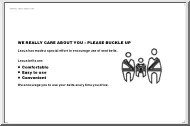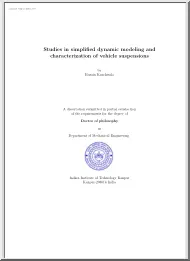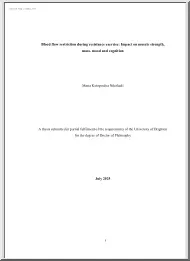Please log in to read this in our online viewer!

Please log in to read this in our online viewer!
No comments yet. You can be the first!
What did others read after this?
Content extract
Famous lines, points and circles of a triangle Perpendicular bisector Theorem: The perpendicular bisectors of a triange intersect each other in one point. Proof: The locus of points equidistant from A and B is the perpendicular bisector of segment AB. The locus of points equidistant from C and B is the perpendicular bisector of segment BC e and f are not in the same line they are not parallel therefore intersect each other Their intersection point is at the same distance from A and B + from C and B as well it is the same distance from A and C M is on the perpendicular bisector of segment AC since M is at equal distance from all verteces, it is the centre of the circumscribed circle if the triangle has an obtuse angle (tompaszögű háromszög), then the centre of the circumscribed circle is outside the triangle acute angles only, then the centre is inside the triangle a right angle, then the centre is on the hypotenuse (Thales theorem) Angle bisector
The locus of points equidistant from two given arms of an angle is an angle bisector Theorem: The angle bisectors of a triangle intersect each other in one point Proof: Line f is an angle bisector of angle BAC: all points in f are equidistant from sides AB and AC Line f is the angle bisector of angle ABC: all points in e are equidistant from sides AB and BC The two bisectors intersect each other in the triangle This point N is at the same distance from sides AB and BC and from AC and BC as well it is equidistant from sides AC and BC as well N is on the angle bisector of ACB since N is at equal distance from all sides it is the centre of the inscribed circle Theorem: If the area of a triangle is T, and the circumference is C then the radius of the inscribed circle is 2T/C Proof: If we draw perpendiculars from the centre of the inscribed circle to the sides, the length of these segment will be the radius of the inscribed circle Therefore the area of the
three triangles ABO, ACO, BCO is (cr)/2, (ar)/2 and (br)/2 The sum of these areas is eyual to the area of the original triangle (ABC) r (a+b+c)2T therefore r2T/ (a+b+c) 2T/ C Theorem: An angle bisector divides the opposite side in the ratio of the neighbouring sides b/b2 = a/c We enlarge side c with side a at vertex B connecting D and C we get an isoceles tringle The external angle of B in DBC triangle is , therefore the angles on the base are /2 therefore they are congruent the angle bisector of B is parallel with DC Applying the párhuzamos szelők tétele we get the original statement An internal angle bisector and the external angle bisectors of the two other verteces meet in one point, which is the centre of the ‘hozzáírható’ circle. The ‘hozzáírható circle is the circle that touches the extension of two sides and the third side of the triangle. Altitude An altitude of a triangle is a segment drawn from a vertex of
a triangle perpendicular to the line containing the opposite side of the triangle Theorem: The altitudes intersect each other in one point. Proof: Draw lines parallel to each of the sides through the opposite vertices to form a new triangle A’B’C’ The quadrilaterals (ABCB’) etc. are paralellograms thus A is the midpoint of B’C’, B is the midpoint of A’C’, and C is the midpoint of A’B’ The sides of the triangle are the midlines of the new triangle From the construction of the triangles we know that the altitudes are the perpendicular bisectors of the sides of the new triangle Applying the theorem that the perpendicular bisectors are concurrent we can conclude that the altitudes of the original triangle are concurrent as well Midlines A midline is the segment connecting the two midpoints of the sides of the triangle Theorem: A midline of a triangle is parallel to the third side and its length is the half of the length of the third side. Proof: F is the
midpoint of AC and G is the midpoint of BC Triangle CFG is similar to CAB (having an angle and the ratio of the neighboring sides (1:2) in common) Thereofre the length of FG is the half of AB, and because of the similarity the corresponding angles are equal, AB is parallel to FG Medians A median of a triangle is a segment from a vertex of a triangle to the midpoint of the oppposite side. Theorem: The medians of a triangle meet in a single point which is two thirds of the distance from each vertex to the midpoint of the opposite side. This point is called the centroid of a triangle, which is the centre of gravity of a triangle. Proof: E is the midpoint of AC and F is the midpoint of BC, point G is the midpoint of AB Medians BE and AF meet at point S EF is half as long as AB and is parallel to AB Angles FAB and AFE, and ABE and BEF are pairs of alternate angles, therefore they are congruent ABS and FES triangles are similar the ratio of similitud is 2:1 (because of the
ratio of AB and EF The proof is the same for the other medians as well, therefore point S is 2/3 of the distance from each vertex to the midpoint of the opposite side. Euler-line The orthocentre (Q), the centroid (G) and the centre of the circumscribed circle (O) lay on a single line, the Euler-line. The distance between the circumcentre and the centroid is half of the distance of the centroid and the orthocentre. Proof: Applications: In mathematics: finding the area of the triangle (using the radius of the inscribed circle) In physics: finding the point of support of a homogen triangle in everyday life we want to build a railway station at equal distance from three villages
The locus of points equidistant from two given arms of an angle is an angle bisector Theorem: The angle bisectors of a triangle intersect each other in one point Proof: Line f is an angle bisector of angle BAC: all points in f are equidistant from sides AB and AC Line f is the angle bisector of angle ABC: all points in e are equidistant from sides AB and BC The two bisectors intersect each other in the triangle This point N is at the same distance from sides AB and BC and from AC and BC as well it is equidistant from sides AC and BC as well N is on the angle bisector of ACB since N is at equal distance from all sides it is the centre of the inscribed circle Theorem: If the area of a triangle is T, and the circumference is C then the radius of the inscribed circle is 2T/C Proof: If we draw perpendiculars from the centre of the inscribed circle to the sides, the length of these segment will be the radius of the inscribed circle Therefore the area of the
three triangles ABO, ACO, BCO is (cr)/2, (ar)/2 and (br)/2 The sum of these areas is eyual to the area of the original triangle (ABC) r (a+b+c)2T therefore r2T/ (a+b+c) 2T/ C Theorem: An angle bisector divides the opposite side in the ratio of the neighbouring sides b/b2 = a/c We enlarge side c with side a at vertex B connecting D and C we get an isoceles tringle The external angle of B in DBC triangle is , therefore the angles on the base are /2 therefore they are congruent the angle bisector of B is parallel with DC Applying the párhuzamos szelők tétele we get the original statement An internal angle bisector and the external angle bisectors of the two other verteces meet in one point, which is the centre of the ‘hozzáírható’ circle. The ‘hozzáírható circle is the circle that touches the extension of two sides and the third side of the triangle. Altitude An altitude of a triangle is a segment drawn from a vertex of
a triangle perpendicular to the line containing the opposite side of the triangle Theorem: The altitudes intersect each other in one point. Proof: Draw lines parallel to each of the sides through the opposite vertices to form a new triangle A’B’C’ The quadrilaterals (ABCB’) etc. are paralellograms thus A is the midpoint of B’C’, B is the midpoint of A’C’, and C is the midpoint of A’B’ The sides of the triangle are the midlines of the new triangle From the construction of the triangles we know that the altitudes are the perpendicular bisectors of the sides of the new triangle Applying the theorem that the perpendicular bisectors are concurrent we can conclude that the altitudes of the original triangle are concurrent as well Midlines A midline is the segment connecting the two midpoints of the sides of the triangle Theorem: A midline of a triangle is parallel to the third side and its length is the half of the length of the third side. Proof: F is the
midpoint of AC and G is the midpoint of BC Triangle CFG is similar to CAB (having an angle and the ratio of the neighboring sides (1:2) in common) Thereofre the length of FG is the half of AB, and because of the similarity the corresponding angles are equal, AB is parallel to FG Medians A median of a triangle is a segment from a vertex of a triangle to the midpoint of the oppposite side. Theorem: The medians of a triangle meet in a single point which is two thirds of the distance from each vertex to the midpoint of the opposite side. This point is called the centroid of a triangle, which is the centre of gravity of a triangle. Proof: E is the midpoint of AC and F is the midpoint of BC, point G is the midpoint of AB Medians BE and AF meet at point S EF is half as long as AB and is parallel to AB Angles FAB and AFE, and ABE and BEF are pairs of alternate angles, therefore they are congruent ABS and FES triangles are similar the ratio of similitud is 2:1 (because of the
ratio of AB and EF The proof is the same for the other medians as well, therefore point S is 2/3 of the distance from each vertex to the midpoint of the opposite side. Euler-line The orthocentre (Q), the centroid (G) and the centre of the circumscribed circle (O) lay on a single line, the Euler-line. The distance between the circumcentre and the centroid is half of the distance of the centroid and the orthocentre. Proof: Applications: In mathematics: finding the area of the triangle (using the radius of the inscribed circle) In physics: finding the point of support of a homogen triangle in everyday life we want to build a railway station at equal distance from three villages




 Just like you draw up a plan when you’re going to war, building a house, or even going on vacation, you need to draw up a plan for your business. This tutorial will help you to clearly see where you are and make it possible to understand where you’re going.
Just like you draw up a plan when you’re going to war, building a house, or even going on vacation, you need to draw up a plan for your business. This tutorial will help you to clearly see where you are and make it possible to understand where you’re going.